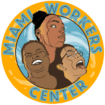For decades, federal, state and local government policies reinforced a system of residential segregation in South Florida.
By Phil Prazan • Published March 1, 2022
The impact of those policies can still be seen decades later where and how people live.
Nadege Green grew up in Little Haiti and graduated from Miami Northwestern Senior High School. NBC 6 met her down the street from the school, outside the first public housing project in Miami: Liberty Square.
“It’s not necessarily visible. Though, as we sit on this race wall, it’s all around us,” said Green, who is the director of community research and storytelling at the Community Justice Project.
She showed NBC 6 what’s left of a race wall. Years ago, it was much taller and divided a Black neighborhood from a white neighborhood along NW 12th street in the Liberty City neighborhood.
“One thing Miami has been very good at since its very founding is marketing this space. When you think about marketing, it’s all of the good things right. I don’t think Miami has considered any of its good things anything that intersects with blackness,” Green said.
Government policy shaped the Miami of today.
During the Great Depression of the 1930s, the Roosevelt Administration and Congress created new programs meant to stabilize the housing market in a rocky time.
One of the programs was the “Home Owners’ Loan Corporation.” Workers from the program divided up and graded different Miami neighborhoods A through D to back long-term home loans for certain parts of town. The grades were largely based on race. An “A” neighborhood included white people. A “D” neighborhood included Black people. “D” neighborhoods would not get access to home loans backed by the Federal Housing Administration, according to the program’s manual.
In the program manual from 1935, government officials at the time wrote “It is necessary that properties shall continue to be occupied by the same social and racial classes. A change in social or racial occupancy generally leads to instability and a reduction in values.” It was too risky to give out loans in those neighborhoods, they argued.
Policies like that kept Black people in areas now known as Overtown, Brownsville, Liberty City, and pockets of other areas of the city. “It set the tone for the understanding of what real estate was going to look like,” said Robin Bachin, the founding director of University of Miami’s Office of Civic and Community Engagement.
Bachin is also a history professor at UM and led a project on housing inequality and racial segregation. She told NBC 6 that way of thinking lasted decades.
“The federal government provided guidelines that stipulated that a stable neighborhood is a segregated neighborhood. That helped enshrine segregation as a feature of urban American for the next century,” Bachin said.
The process has also been detailed in the book by John Hopkins professor N.D.B. Connolly, A World More Concrete.
Many Black people were forced to rent from white landowners because the neighborhood lines outlined by the Home Owners’ Loan Corporation cut off access to home mortgage loans for African Americans and people from the Caribbean.
According to Green, that meant white families could build generational wealth by passing down real estate to their descendants. Black families never could and now are more likely to live in poverty and continue to be renters.
“If you grew up in an area like Liberty City, it was very possible that your family were renters,” Green said. “The reality is wealth. We know that wealth transfer and access is often intrafamily.”
The neighborhoods outlined by the 1930s Home Owners’ Loan Corporation map are largely the same area where Black people live today and where the vast majority of people are renters, according to an NBC 6 analysis of PolicyMap, which presents data from the census.

